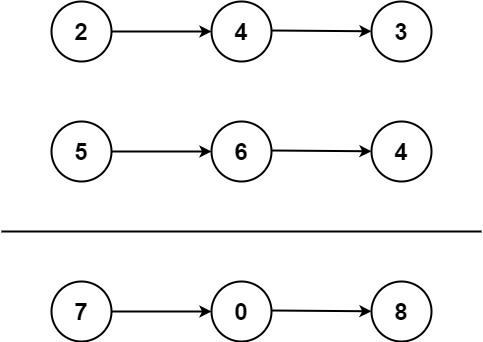本文最后更新于:2022年8月26日 晚上
给你两个 非空 的链表,表示两个非负的整数。它们每位数字都是按照 逆序 的方式存储的,并且每个节点只能存储 一位 数字。
请你将两个数相加,并以相同形式返回一个表示和的链表。
你可以假设除了数字 0 之外,这两个数都不会以 0 开头。
示例 1:

| 输入:l1 = , l2 =
输出:
解释:342 + 465 = 807.
|
示例 2:
示例 3:
| 输入:l1 = [9,9,9,9,9,9,9], l2 = [9,9,9,9]
输出:[8,9,9,9,0,0,0,1]
|
提示:
- 每个链表中的节点数在范围
[1, 100] 内
0 <= Node.val <= 9- 题目数据保证列表表示的数字不含前导零
Solution
1
2
3
4
5
6
7
8
9
10
11
12
13
14
15
16
17
18
19
20
21
22
23
24
25
26
27
28
29
30
31
32
33
34
35
36
37
38
39
40
41
42
43
44
45
46
47
48
49
|
class Solution {
public:
ListNode* addTwoNumbers(ListNode* l1, ListNode* l2) {
ListNode* l3 = new ListNode(-1);
ListNode* p = l3;
int up = 0;
while(l1 && l2){
p->next = l1;
p = p->next;
int sum = l1->val+l2->val+up;
p->val = sum %10;
up = sum/10;
l1 = l1->next;
l2 = l2->next;
}
while(l1){
p->next = l1;
p = p->next;
int sum = l1->val+up;
p->val = sum%10;
up = sum/10;
l1 = l1->next;
}
while(l2){
p->next = l2;
p = p->next;
int sum = l2->val+up;
p->val = sum%10;
up = sum/10;
l2 = l2->next;
}
if(up){
p->next = new ListNode(up);
}
return l3->next;
}
};
|
1
2
3
4
5
6
7
8
9
10
11
12
13
14
15
16
17
18
19
20
21
22
23
24
25
26
| class Solution {
public:
ListNode* addTwoNumbers(ListNode* l1, ListNode* l2) {
ListNode *dummyHead = new ListNode(-1);
ListNode *cur = dummyHead;
int carry = 0;
while (l1 || l2) {
int n1 = l1 ? l1->val : 0;
int n2 = l2 ? l2->val : 0;
int sum = n1 + n2 + carry;
cur->next = new ListNode(sum % 10);
cur = cur->next;
carry = sum / 10;
if (l1) {
l1 = l1->next;
}
if (l2) {
l2 = l2->next;
}
}
if (carry > 0) {
cur->next = new ListNode(carry);
}
return dummyHead->next;
}
};
|
java
1
2
3
4
5
6
7
8
9
10
11
12
13
14
15
16
17
18
19
20
21
22
23
24
25
26
27
28
29
30
31
32
33
34
35
36
37
38
39
40
41
42
|
class Solution {
public ListNode addTwoNumbers(ListNode l1, ListNode l2) {
if (l1 == null || l2 == null) {
return l1 == null ? l2 : l1;
}
ListNode head = null;
ListNode tail = null;
int carry = 0;
while (l1 != null || l2 != null) {
int n1 = l1 != null ? l1.val : 0;
int n2 = l2 != null ? l2.val : 0;
int sum = n1 + n2 + carry;
if (head == null) {
head = tail = new ListNode(sum % 10);
} else {
tail.next = new ListNode(sum % 10);
tail = tail.next;
}
carry = sum / 10;
if (l1 != null) {
l1 = l1.next;
}
if (l2 != null) {
l2 = l2.next;
}
}
if (carry > 0) {
tail.next = new ListNode(carry);
}
return head;
}
}
|
